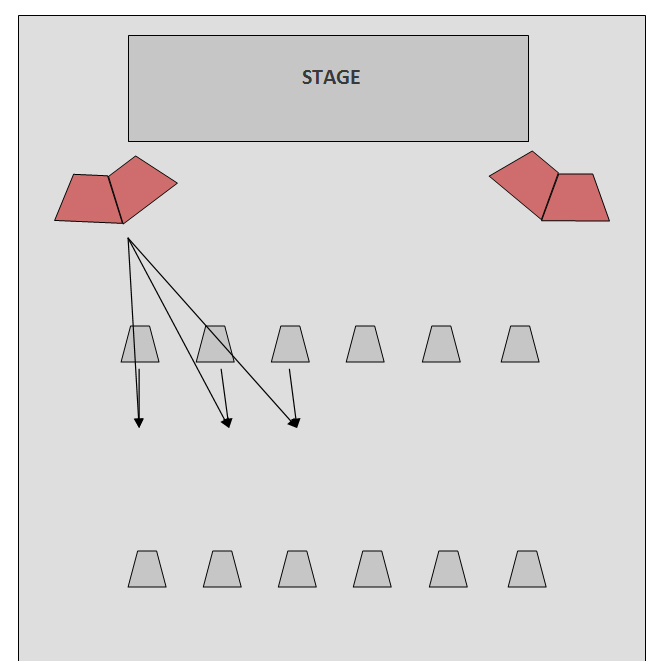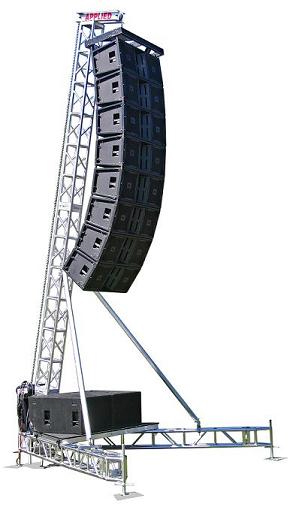
Tried And True
For many years, the international theatrical community and many AV presentations relied almost entirely on distributed systems.
By spacing a number of small or medium sized loudspeakers across the front of the room, and perhaps once or twice again towards the rear of the room (depending on how deep the room is), a distributed loudspeaker system can provide even coverage, minimal feedback issues, and the ability to alter the balance of the sub-mixes in relation to the proximity of the listener to the stage.
For example, seats in the front rows by the orchestra pit need little or no orchestra in the system – and perhaps minimal vocal content.
Conversely, seats in the rear of the theatre may need considerable reinforcement of vocals and instrumentals. Of course, the second, third, and any additional distributed lines of loudspeakers will need to be accurately delayed to the front-most sound source (Figure 2).
Tried, And, Well, Not So True
A common practice in the pre-line array era was to locate large loudspeakers on each side of the stage, augmented with smaller distributed delay speakers (Figure 3).
Tuning and adjusting such systems is problematic because as you move from seat to seat the correct delay time changes. Therefore, this is not a recommended solution unless the large loudspeakers are used only for track playback.
A solid rule of thumb is that whenever delay loudspeakers are part of a design, it’s always best to keep them in-line with the first source, rather than at a vector angle.
Columnar Arrays
In small- and medium-sized rooms that are quite reverberant, such as houses of worship with high ceilings and many reflective surfaces (wooden pews, glass windows, etc.), the columnar array can provide an excellent solution.
A columnar array (also commonly called a line source and/or a column loudspeaker) is especially relevant if the location of the columns is such that the presenter needs to walk out in front of them from time to time. They are very forgiving in respect to feedback control, especially when lavalier microphones are employed.
I’ve heard excellent results from two modest-sized columns in a 200-seat church that’s nearly twice as deep as it is wide. The presence and intelligibility in the rear row is as good as hat of the front row, and musicality is excellent when the columns are augmented by small subwoofers.
Take It Outside
Outdoor events are altogether different, as there are no reflections to deal with – unless a building is close enough and large enough to cause a reflective return. Small outdoor gatherings can be served very well with good quality point source systems or micro-sized line arrays.
Assuming no nearby buildings, larger gatherings are a perfect fit for larger line array rigs, either ground stacked, suspended from the stage structure, or flown from scaffolding or purpose-designed support towers (Figure 4).
However, a critical issue for outdoor shows is to look carefully at the mechanical means of suspension. Outdoor events include the possibility of sudden high winds, rain, and earthquakes. If towers are used for suspension, then a fall-zone(an the area in which the rig will land if the suspension towers collapse or fall over) must be cordoned off so that no one will be injured.
Wind storms can occur very rapidly, but usually with some foreknowledge. Earthquakes, on the other hand, come without any warning. Either can topple or destroy a seemingly solid structure in a matter of seconds.
Always keep safety first at the top of your prioririty list.
Happy trails!
Ken DeLoria is senior technical editor of ProSoundWeb and Live Sound International and has had a diverse career in pro audio over more than 30 years. He is the founder and former owner of Apogee Sound, and for more than 30 years designed pro audio products, including the world’s first intelligent power amplifier equipped with an embedded microcontroller (the Apogee DA-800) as well as the TEC Award winning Apogee AE-9 loudspeaker. He has also mixed innumerable shows and tuned a plethora of sound systems with an emphasis on taming difficult acoustical environments, with credits that include theatrical productions, the first two Super Bowls that utilized high-fidelity concert-style sound systems (Super Bowls XVII and XIX), the 1984 and 1996 Summer Olympics, three Democratic National Conventions, six consecutive Grammy and Oscar Awards, and more than 100 permanent systems in domestic and worldwide installations.
Editor’s note: We’ll be posting new chapters in this series on a regular basis so be sure to check back often. Go here to read chapter 1.



